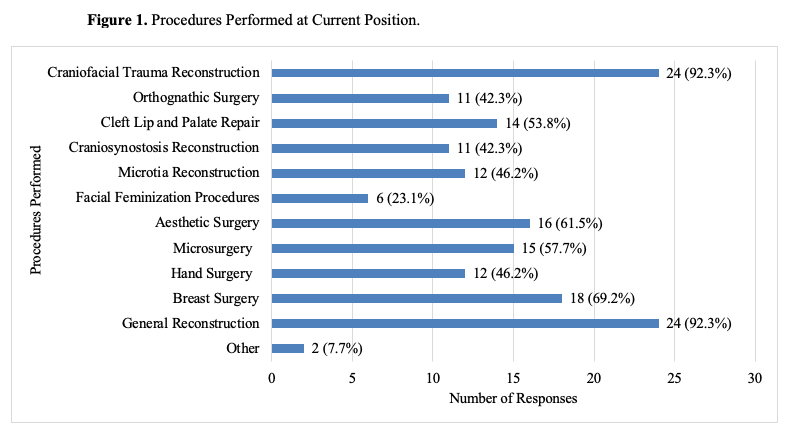Trends in Craniofacial Fellowship Career Outcomes: A Call for Expanding Professional Opportunities in Craniofacial Surgery
Ashley E. Rogers1, Adaah A. Sayyed2, Julian Marable2, Raymond Harshbarger III3, Peter J. Taub4, Jesse Taylor5, Stephen B. Baker1
1Department of Plastic and Reconstructive Surgery, MedStar Georgetown University Hospital, Washington, DC, USA; 2Georgetown University School of Medicine, Washington, DC, USA; 3Craniomaxillofacial Surgery, Dell Medical School, UT Austin, Austin, TX, USA; 4Plastic and Reconstructive Surgery Department, Mount Sinai Hospital, New York, NY, USA; 5Division of Plastic and Reconstructive Surgery, Children's Hospital of Philadelphia, Philadelphia, PA, USA
Background: With increasing numbers of trainees completing a craniofacial surgery fellowship in recent years, the rise within a fairly static job market is concerning. Many factors have increased the demand and reduced barriers for craniofacial expertise despite few available practice positions, such as gender affirmation and aesthetic procedures. Given these challenges facing the next generation of craniofacial surgeons, we aim to evaluate the current state of career prospects for recent craniofacial graduates.
Methods: Upon approval from the American Society of Craniofacial Surgeons (ASCFS), an anonymous online survey invitation was sent to all craniofacial surgeons who graduated from accredited craniofacial fellowships from 2016 to 2021. The survey period began on December 10, 2021 and ended on January 27, 2022. Descriptive statistics were used to summarize study results.
Results: A total of 124 eligible participants were identified by ASCFS, of which 30 (24.2%) responded to the survey. The craniomaxillofacial case distribution at respondentsí current practice varied, with 42.3% reporting a 50-75% craniofacial case load and 38.5% reporting below 25%. Craniofacial trauma reconstruction was performed most at current positions (92.3%), followed by general reconstruction (92.3%) and breast surgery (69.2%), with least common procedures including facial feminization (23.1%). Most respondents reported desiring an increased craniomaxillofacial case load (65.4%). Seven (26.9%) were unable to secure their current position prior to completion of craniofacial fellowship, and many respondents (80.0%) cited low craniofacial job availability to be a limiting factor in their job search. Respondent recommendations to improve fellowship comprehensiveness and to increase candidate competitiveness within the job search included increased facial feminization, facial aesthetic, and microsurgical experience during fellowship training.
Conclusions: This survey is notable for the unique perspective it obtains from recently graduated craniofacial fellows regarding the gap between their skills following fellowship and ones that would have allowed them to be more competitive in the job search. To adapt to trends in craniomaxillofacial surgery, training programs should implement minimization standards for exposure of fellows to facial feminization, orthognathic surgery, facial aesthetics, and microsurgical reconstruction. Establishing a feedback system eliciting recommendations from recent graduates is a sage investment to ensure training programs are adapting alongside the field. Expansion of training beyond the management of congenital deformities can provide a revitalization of the field and prepare plastic surgeons to remain innovators in facial plastic surgery as competition increases.
Back to 2022 Posters

